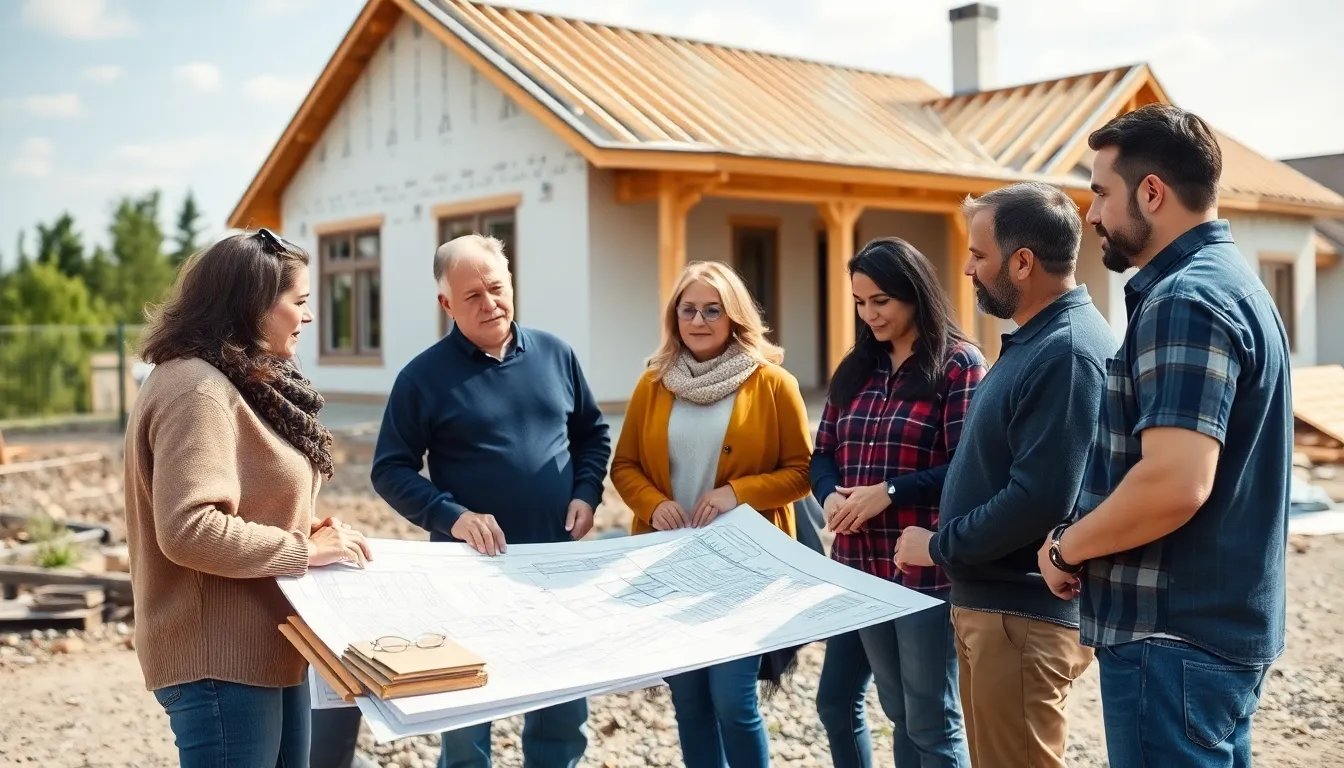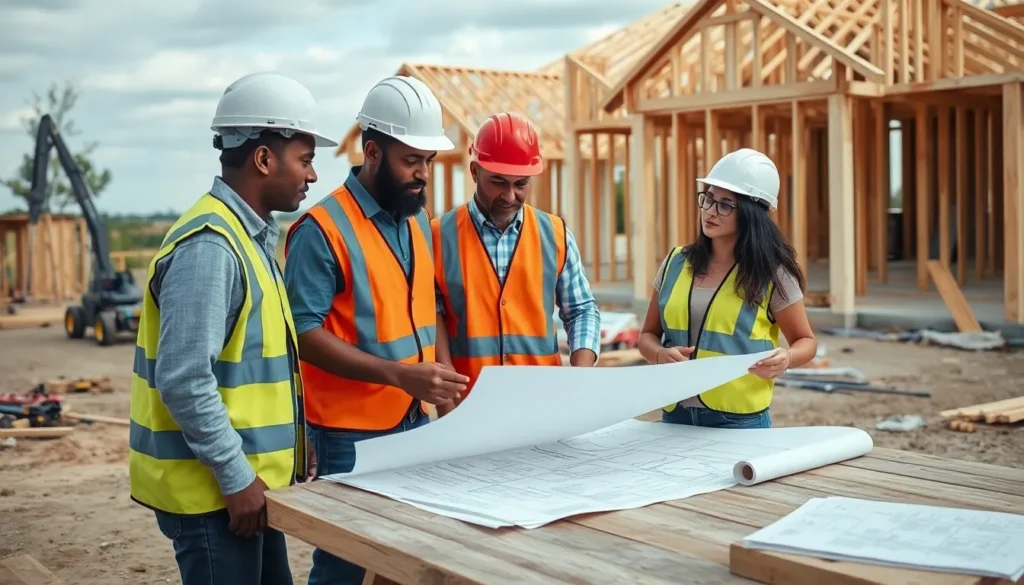Table of Contents
ToggleBuilding a home is an exciting journey filled with dreams and aspirations. However, navigating the construction timeline can often feel overwhelming. Understanding the stages of home construction not only helps homeowners manage expectations but also ensures a smoother process from start to finish.
From the initial design phase to the final walkthrough, each step plays a crucial role in bringing a vision to life. Knowing what to expect at each stage can empower homeowners to make informed decisions and avoid common pitfalls. This article will break down the typical timeline of home construction, providing insights into each phase and tips for staying on track.
Understanding Home Construction Timeline
Home construction involves several key stages that significantly impact the overall timeline. Understanding these stages enables homeowners to manage expectations and navigate the building process effectively.
Importance of a Construction Timeline
A construction timeline serves as a roadmap for the entire project. It sets clear deadlines for materials, labor, and inspections. With a structured timeline, homeowners can identify potential delays early, allocate resources efficiently, and adjust plans as needed. Staying on schedule reduces construction costs and minimizes stress throughout the building process.
Key Phases of Home Construction
Home construction typically involves five essential phases:
- Pre-Construction
Pre-construction includes design finalization, obtaining permits, and selecting contractors. This phase can last from a few weeks to several months.
- Site Preparation
Site preparation involves clearing and grading the land, marking the foundation, and installing utilities. This stage usually takes 1 to 2 weeks, depending on site conditions.
- Foundation
Foundation work includes pouring concrete and building the basement or crawl space. This phase lasts around 2 to 4 weeks, depending on the complexity.
- Framing
Framing establishes the structure of the home, including walls, roofing, and windows. This phase often takes 4 to 6 weeks, influenced by the size and design.
- Finishing
Finishing involves plumbing, electrical work, drywall installation, and interior/exterior finishes. This critical phase can take 8 to 12 weeks, with final inspections preceding the walkthrough.
Each phase contributes significantly to the overall timeline, and understanding them can enhance project efficiency.
Pre-Construction Phase

The pre-construction phase sets the foundation for a successful home-building project. This stage involves critical activities like planning, design finalization, and securing necessary permits.
Planning and Design
Planning and design frame essential elements of the project. Homeowners work closely with architects and designers to finalize blueprints, material selections, and interior layouts. During this phase, several decisions arise, including:
- Budgeting: Homeowners must outline their budgets and financial capabilities.
- Style and Preferences: Decisions about style preferences, such as modern or traditional, affect design elements.
- Timeline Expectations: Establishing a realistic timeline helps align the schedule with construction progress.
Clear communication and detailed planning minimize misunderstandings and enhance the overall project direction.
Obtaining Permits
Obtaining permits is crucial for legal compliance and building safety. Homeowners secure necessary permits from local authorities, which typically include:
- Building Permit: Required for any construction activity.
- Zoning Permit: Ensures the project adheres to local zoning regulations.
- Environmental Permits: Necessary if the project impacts wetlands or wildlife habitats.
The permit application process can take anywhere from a few weeks to several months, depending on local regulations. Effective planning helps streamline this process, ensuring construction begins on time.
Construction Phase
The construction phase involves executing the plans established during the pre-construction phase. This stage consists of multiple crucial steps, including site preparation, foundation work, framing, and installations. Each step plays a vital role in ensuring the home’s structural integrity and functionality.
Site Preparation
Site preparation lays the groundwork for construction. Activities include clearing vegetation, grading the land, and excavating for utilities, taking approximately 1 to 2 weeks. Effective site preparation ensures proper drainage and foundation support. Homeowners should expect heavy machinery on-site and may encounter noise and dust during this process.
Foundation and Framing
The foundation and framing stages create the home’s structure. Foundation work, including pouring concrete and constructing basements or crawl spaces, lasts around 2 to 4 weeks. Proper foundation installation is crucial for stability and preventing future issues. Following this, framing establishes walls, roof structures, and windows, typically taking 4 to 6 weeks. This phase requires skilled labor to ensure accuracy and support for the entire building.
Installation of Systems
The installation of systems phase focuses on essential home features. This phase covers plumbing, electrical wiring, HVAC (heating, ventilation, and air conditioning) installations, and insulation, lasting about 8 to 12 weeks. Each system must comply with local codes and undergo inspections to ensure safety and functionality. Final inspections commonly occur before the walkthrough, signaling readiness for the finishing touches.
Post-Construction Phase
The post-construction phase marks the transition from building to moving in. Homeowners finalize their new spaces, ensuring everything meets expectations and is ready for occupancy.
Final Inspections
Final inspections verify the home’s compliance with building codes, safety regulations, and contractual agreements. Inspectors assess structural integrity, electrical systems, plumbing, and safety features. This process typically occurs after finishing work but before the move-in date. Homeowners can expect this phase to last 1 to 2 weeks, depending on local regulations and inspection schedules. A passed inspection allows for necessary permits to close out, ensuring the home is safe and legally compliant.
Move-In Process
The move-in process involves preparing the home for occupancy. Homeowners often schedule utility activation and any necessary clean-up or touch-ups during this phase. Setting up essential services, such as electricity, water, and internet, should occur at least a week before moving in. Moving day can require 1 to 3 days, depending on the amount of belongings and the assistance available. After the move, homeowners should conduct a thorough walkthrough to verify that every space meets their expectations and is free of defects.
Common Delays in Home Construction
Delays in home construction often stem from various external factors that can disrupt the planned timeline. Understanding these common issues helps homeowners better prepare for potential setbacks.
Weather Issues
Weather-related delays significantly affect construction schedules. Heavy rain, snow, or extreme temperatures can halt progress on multiple phases, particularly during site preparation and foundation work. Adverse weather conditions may delay material deliveries and prevent contractors from performing essential tasks, such as pouring concrete. For example, excessive rainfall can lead to unsafe site conditions, extending expected project timelines by several days or even weeks.
Supply Chain Challenges
Supply chain challenges frequently impact the availability of critical materials and components. Shortages in lumber, drywall, fixtures, and appliances often delay construction schedules, especially when a surge in demand occurs or transportation issues arise. Construction projects may experience increased wait times for necessary materials, extending completion dates. According to industry reports, construction materials costs increased by up to 20% in 2021 due to supply chain disruptions, leading to further delays as homeowners adjust their budgets and timelines to accommodate these challenges.
Navigating the home construction timeline can be a rewarding yet challenging experience. Homeowners equipped with knowledge about each phase can better manage their expectations and make informed decisions. Understanding the importance of planning and preparation lays the groundwork for a smoother process.
Being aware of potential delays and having contingency plans in place can further enhance project efficiency. Ultimately, this journey culminates in the joy of moving into a new home that reflects personal style and meets functional needs. Embracing the construction timeline empowers homeowners to take control and enjoy the transformation of their vision into reality.







